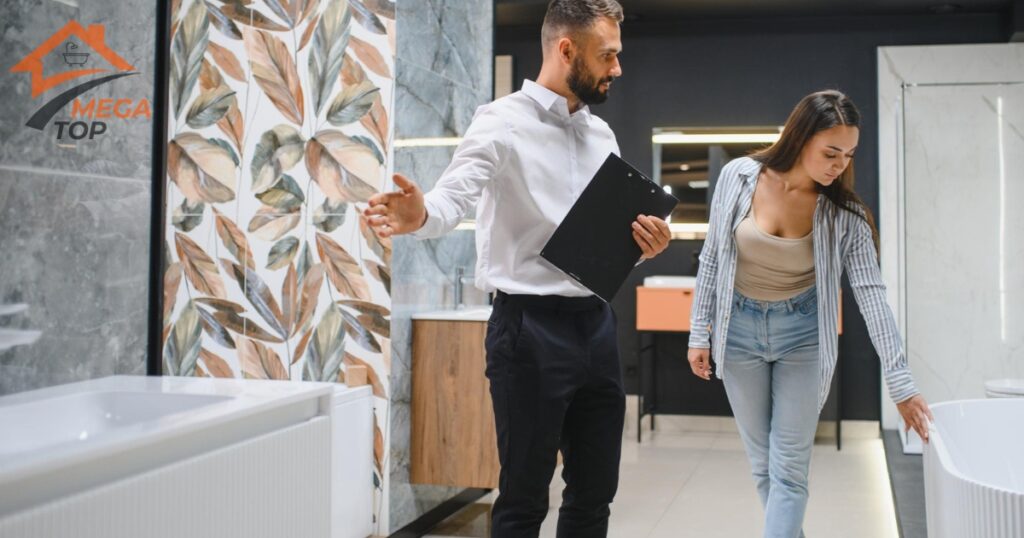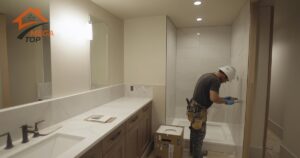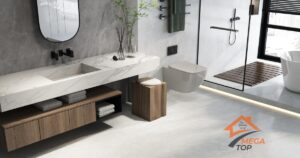INTRO
When planning a bathroom remodeling project, replacing old tiles, tubs, and sinks can be expensive and time-consuming. But what if you could restore these surfaces instead of replacing them? Resurfacing—also known as refinishing or reglazing—offers a cost-effective way to give your bathroom a fresh, updated look. But does it provide long-lasting results? Let’s explore whether resurfacing is a smart investment or just a short-term fix.
What Is Resurfacing in Bathroom Remodeling?
Resurfacing is the process of applying a new coating to existing tiles, bathtubs, or sinks to restore their original appearance. Instead of tearing out and replacing fixtures, professionals use special refinishing materials to create a smooth, durable finish.
Resurfacing vs. Replacement: What’s the Difference?
- Resurfacing: A refinishing process that repairs chips, cracks, and discoloration while adding a fresh coating.
- Replacement: Involves removing the old fixture and installing a brand-new one, which is more expensive and labor-intensive.
The Pros & Cons of Resurfacing Tiles, Tubs, and Sinks
Before deciding if resurfacing is right for you, consider the advantages and disadvantages.
Pros of Resurfacing
✅ Cost-Effective – Resurfacing costs 70-80% less than a full replacement.
✅ Quick Turnaround – Most refinishing jobs take a day or two, compared to weeks for a full remodel.
✅ Eco-Friendly – Reduces waste by keeping your existing fixtures instead of sending them to a landfill.
✅ Customizable Finishes – Choose from different colors, textures, and high-gloss coatings.
Cons of Resurfacing
❌ Not as Permanent as Replacement – While durable, resurfaced fixtures may not last as long as brand-new ones.
❌ Requires Proper Maintenance – Harsh cleaners can wear down the finish over time.
❌ Surface Condition Matters – Severely damaged or structurally weak tiles, tubs, or sinks may not be suitable for resurfacing.
How Long Does Resurfacing Last?
One of the biggest concerns homeowners have is the durability of resurfaced surfaces. With proper care, resurfacing can last:
- Tiles: 10-15 years
- Bathtubs: 10-15 years
- Sinks: 8-10 years
💡 Pro Tip: The quality of materials and application technique significantly impact lifespan. Professional refinishing lasts longer than DIY kits.
DIY vs. Professional Resurfacing: Which One Is Better?
DIY Resurfacing
💰 Lower cost but requires skill and patience
🛠 Shorter lifespan (1-3 years) due to thinner coatings
⚠️ Common issues: Uneven coating, peeling, and quick wear
Professional Resurfacing
💎 More durable and lasts 10+ years
🏠 Better adhesion & smoother finish
✔️ Warranty options available for added peace of mind
👉 Bottom Line: If you want long-lasting results, professional refinishing is the better choice.
Best Materials for Long-Lasting Resurfacing
The type of refinishing materials used directly affects durability. The best options include:
- Epoxy Coatings – Strong adhesion, high resistance to wear.
- Polyurethane Finishes – Resistant to moisture and daily use.
- High-Gloss Acrylic Reglazing – Creates a sleek, modern look while protecting against stains.
How to Maintain a Resurfaced Bathroom for Maximum Lifespan
To extend the life of your resurfaced fixtures, follow these maintenance tips:
✅ Use Non-Abrasive Cleaners – Avoid harsh scrubbing pads and acidic products.
✅ Wipe Down Surfaces Regularly – Prevents soap scum buildup.
✅ Avoid Heavy Impact – Dropping heavy items can chip or crack the coating.
✅ Don’t Let Water Sit – Standing water can wear down the finish over time.
When Should I Replace Instead of Resurface?
While resurfacing is a great solution for many bathrooms, replacement may be necessary if:
❌ Your tub or sink has deep structural damage (cracks, rust, leaks).
❌ The surface is heavily pitted or weakened.
❌ You want a completely different layout or design.
💡 Pro Tip: If you’re planning a full-scale bathroom remodeling, it might be worth investing in brand-new fixtures instead of resurfacing.
Testimonials from MegaTop™ Customers
⭐ “Resurfacing saved me thousands of dollars! My bathtub looks brand new, and the process was so quick.” — Tallulah F., Toms River, NJ
⭐ “I was skeptical about resurfacing, but MegaTop™ did an amazing job. My tiles look freshly installed!” — Mark P., Prescott, AZ
⭐ “So happy I chose refinishing instead of replacement. The results are beautiful, and it only took a day!” — Lisa M., Lysander, NY
Did You Know?
🔹 Did you know that refinishing a bathtub can extend its lifespan by up to 15 years? That’s nearly as long as a brand-new tub but at a fraction of the cost!
TL;DR Summary
- Resurfacing is an affordable alternative to replacing bathroom fixtures.
- Professional refinishing lasts 10-15 years with proper maintenance.
- Best materials: Epoxy, polyurethane, and high-gloss acrylic coatings.
- Avoid harsh cleaners to preserve the new finish.
- Replacement is better for heavily damaged or outdated fixtures.
Thinking about bathroom remodeling but don’t want to spend thousands on new fixtures? MegaTop™ specializes in professional resurfacing services that save you time and money! Contact us today for a consultation! 🚿✨
Get in Touch
Ready to transform your bathroom with a stunning new floor? Contact us today for a free estimate!
Fill out our online contact form 📧 or call by phone 📞 for a fast response.
We’re here to answer your questions, provide expert advice, and guide you through every step of the process. Call us, email us, or fill out our quick online form to get started. Let’s bring your vision to life!
FAQ
Resurfacing is typically 70-80% cheaper than replacing tiles, tubs, or sinks. A full replacement can cost $3,000-$5,000, while refinishing is usually $300-$800 per fixture.
Yes, but only minor cracks and surface stains. Deep structural damage may require replacement.
Absolutely! Porcelain, ceramic, and fiberglass can all be resurfaced with the right refinishing materials.
Most refinishing jobs require 24-48 hours to fully cure before use.
Use mild, non-abrasive cleaners like dish soap and warm water. Avoid bleach, ammonia, or heavy scrubbing pads.





